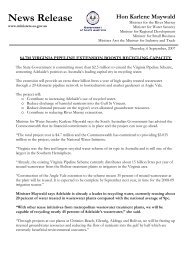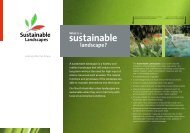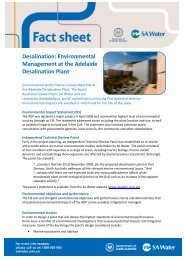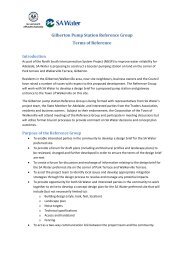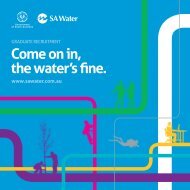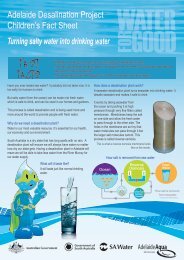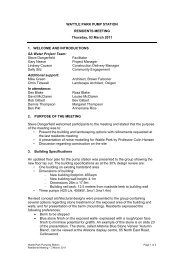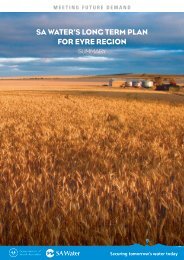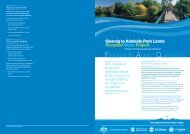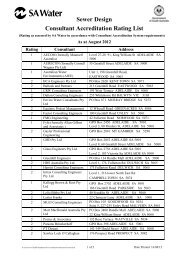Code of Practice - Irrigated Public Open Space - SA Water
Code of Practice - Irrigated Public Open Space - SA Water
Code of Practice - Irrigated Public Open Space - SA Water
You also want an ePaper? Increase the reach of your titles
YUMPU automatically turns print PDFs into web optimized ePapers that Google loves.
The City <strong>of</strong> Salisbury now has some thirty six major<br />
wetlands, covering several square kilometres in all. In<br />
addition, all new residential subdivisions in the past ten<br />
years have been required to install wetlands to contain<br />
stormwater onsite as much as possible. Large industrial<br />
developments have also been actively encouraged to develop<br />
wetlands for the same reason and in order to contain<br />
potential industrial spills. Collectively, these initiatives have<br />
effectively eliminated flood risk in an otherwise flood-prone<br />
area and have dramatically increased the wildlife habitat<br />
and biodiversity within the City.<br />
Importantly, they have also substantially reduced the flow<br />
<strong>of</strong> polluted surface water into the fragile Barker Inlet<br />
estuary, opened new opportunities for the economic<br />
recycling <strong>of</strong> stormwater and reduced demand on water<br />
sourced from the River Murray.<br />
<strong>Water</strong> for Industry<br />
The City <strong>of</strong> Salisbury has six ASR sites currently operating,<br />
harvesting a total <strong>of</strong> 1,895 megalitres (ML) <strong>of</strong> stormwater<br />
annually. Two ASR sites are used to provide water to<br />
industry which would otherwise rely on mains water as the<br />
primary source. The Parafield Wetlands provide 1,100 ML<br />
per annum to G H Michell and Sons, Australia’s largest<br />
wool processing company. The Kaurna Park Wetlands<br />
provides 100 ML <strong>of</strong> water to Heynes Nursery. The<br />
Edinburgh Parks Storm <strong>Water</strong> Supply Project is currently<br />
under development and will yield approximately 1,500 ML<br />
<strong>of</strong> water annually supplying General Motors Holden,<br />
DSTO, Edinburgh Airport and the Edinburgh Parks<br />
Industrial Precinct.<br />
Irrigation<br />
AQUIFIERSTORAGE ANDRECOVERY(ASR)<br />
Injection<br />
Well Wetland/Basin<br />
Wet Season<br />
DrySeason<br />
Sewage<br />
Treatment<br />
Stormwater/<br />
Wastewater<br />
Sewage<br />
GroundwaterLevel<br />
ConfiningLayer<br />
Aquifer<br />
Storm/Wastewatertoaquiferinwetseason<br />
Recoveryfromaquiferindryseason<br />
Natural<br />
Recharge<br />
APPENDICES<br />
38<br />
<strong>Water</strong> for <strong>Irrigated</strong> <strong>Public</strong> <strong>Open</strong> <strong>Space</strong><br />
In addition to supporting industry with supplies <strong>of</strong><br />
alternative water sources, the City <strong>of</strong> Salisbury has invested<br />
significantly in developing alternative water supplies to<br />
irrigated public open space. In 1983 Salisbury had only<br />
6% <strong>of</strong> its irrigated area supplied by alternative water<br />
supplies to mains water. In 2006 this increased to 56%.<br />
City <strong>of</strong> Salisbury <strong>Water</strong> Use Pr<strong>of</strong>ile 2006<br />
– <strong>Irrigated</strong> <strong>Public</strong> <strong>Open</strong> <strong>Space</strong><br />
<strong>Water</strong> Supply Native Re-claimed Storm<br />
Mains Ground Effluent <strong>Water</strong> Total<br />
<strong>Water</strong> ASR<br />
Area ha 75 48 11 35 169<br />
Area % 44% 28% 7% 21% 100%<br />
ML / Annum 285 183 42 134 643<br />
Reclaimed<br />
Effluent<br />
7%<br />
CITYOF<strong>SA</strong>LISBURYWATERUSEPROFILE2006<br />
Stormwater ASR<br />
21%<br />
Mains<br />
44%<br />
Extension <strong>of</strong> the ASR program has also seen schools within<br />
the council area being provided with water to irrigate their<br />
sports grounds. Currently eight schools are being supplied<br />
with ASR based water with a further thirty sites identified<br />
for connection over the next three years.<br />
<strong>Water</strong> for the Community (Mawson Lakes)<br />
Native<br />
Ground <strong>Water</strong><br />
28%<br />
The developing suburb <strong>of</strong> Mawson Lakes in the City <strong>of</strong><br />
Salisbury local government area will cater for approximately<br />
10,000 residents when complete in 2010. This innovative<br />
development uses recycled water technology to provide both<br />
potable mains water and alternative recycled water to every<br />
house in the development.<br />
This recycled water system is the product <strong>of</strong> a unique<br />
partnership between the State Government’s Land<br />
Management Corporation, <strong>SA</strong> <strong>Water</strong>, Delfin Lend Lease<br />
and the City <strong>of</strong> Salisbury.<br />
The recycled water is a mix <strong>of</strong> treated wastewater from the<br />
<strong>SA</strong> <strong>Water</strong> Bolivar Wastewater Treatment Plant and cleansed<br />
stormwater from the Parafield Airport Wetlands.



